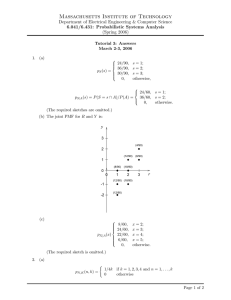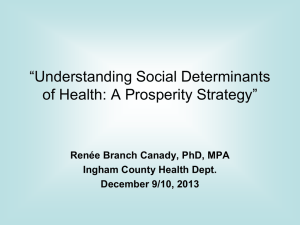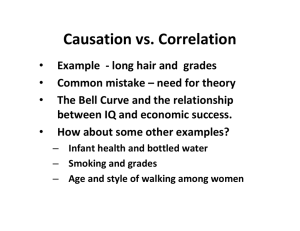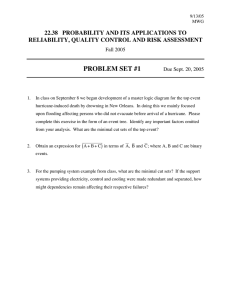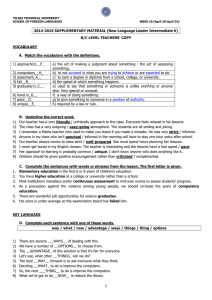DP
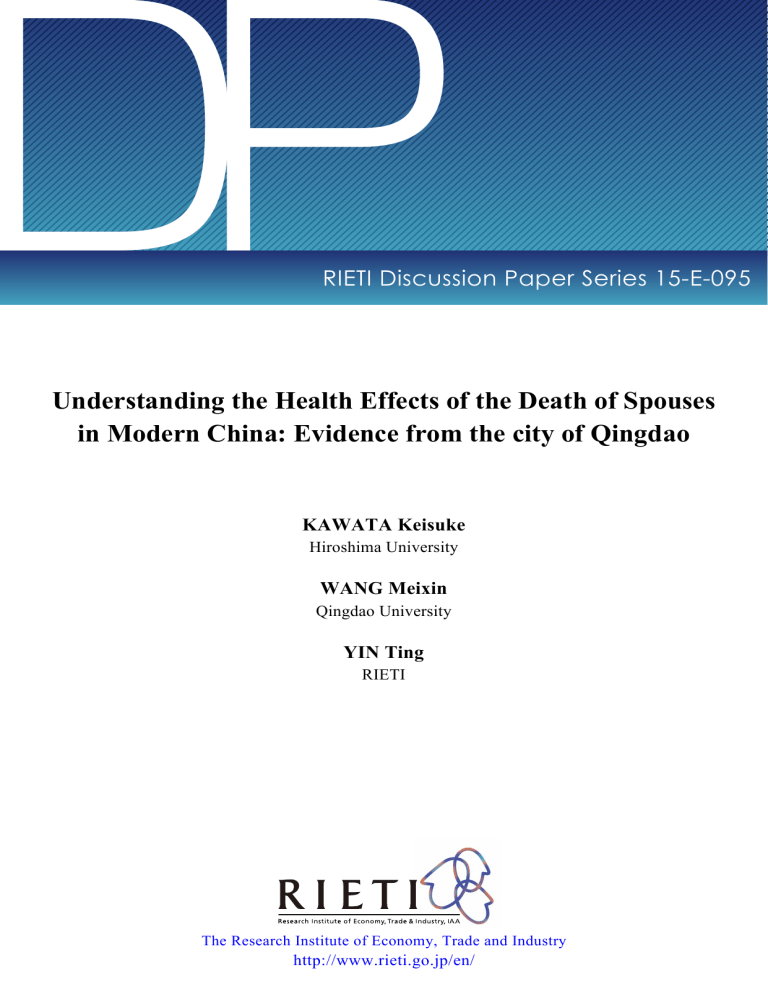
DP
RIETI Discussion Paper Series 15-E-095
Understanding the Health Effects of the Death of Spouses in Modern China: Evidence from the city of Qingdao
KAWATA Keisuke
Hiroshima University
WANG Meixin
Qingdao University
YIN Ting
RIETI
The Research Institute of Economy, Trade and Industry http://www.rieti.go.jp/en/
RIETI Discussion Paper Series 15-E-095
July 2015
Understanding the Health Effects of the Death of Spouses in Modern
China: Evidence from the city of Qingdao
KAWATA Keisuke
Hiroshima University
WANG Meixin
School of Economics, Qingdao University
YIN Ting
Research Institute of Economy, Trade & Industry
Abstract
This paper provides new empirical results to understand the impacts of the death of spouses on the surviving partner’s health status. We use the survey data for elderly persons in the city of Qingdao in China, which include information for individual health status and other basic characteristics. Based on the probit estimation and the propensity-score approaches, we estimate the impacts of the death of spouses on health status. These estimation results consistently show the heterogeneous health effects between males and females; we can observe statistically significant negative effects on females’ health status, while any statistically significant effects for males were unable to be found. One of the possible interpretations of these results is the unique policy in the Mao era
(1949-1976).
Keywords
: Health status, Death of spouse, Propensity-score matching
JEL classification
: I12, J12
RIETI Discussion Papers Series aims at widely disseminating research results in the form of professional papers, thereby stimulating lively discussion. The views expressed in the papers are solely those of the author(s), and neither represent those of the organization to which the author(s) belong(s) nor the Research Institute of Economy, Trade and Industry.
2
1 This study is conducted as a part of the Project "A Socioeconomic Analysis of Households in Environments Characterized by Aging Population and Low Birth Rate" at undertaken at the Research Institute of Economy, Trade and Industry (RIETI). I would like to express my appreciation to Masahisa Fujita, Masayuki Morikawa, Mitsuhiro Fukao, and Yanfei Zhou, and Discussion Paper seminar participants at RIETI.
E-mail address: keisuke@hiroshima-u.ac.jp
1
1.
Introduction
Heath maintenance of elderly persons becomes high priority policy objects, especially in the East Asian countries (China, Japan, and Korea) due to aging population. In such countries, the health care service for elderly persons is conventionally provided by family members, for instance their children and spouse.
However, the number of children is dramatically decreased in recent years, and the roll of spouse then become more important to maintain health status. Therefore, in the East Asian countries, the death of spouse may have more serious impacts on survivor’s health status than in other countries.
In this paper, we try to estimate the effect of spouse death on health status using a recent survey in urban China. This survey focuses on elderly persons in Qingdao city and includes the information of their health status and other basic characteristics. These information then allow us to estimate the health effect of spouse death with rich control variables.
Our analysis shows heterogeneous effects of spouse death between males and females. From the descriptive statistics, we first observe the gap of health status between females who lost spouse and those who do not, while there are no statistically significant differences for males. However, the descriptive statistic also
2
shows that other characteristics, such as age and the number of children, are also significantly different between individuals who lost spouse and those who do not.
The average differences of health status may be then biased estimators, and more sophisticated methods are required to obtain more credible estimators.
To adjust for observable differences between individuals, we then use two types approach; the probit estimation with control variables and the propensity-score matching. The estimation results of both approaches also consistently show the heterogeneous effects of the spouse death between males and females: we can observe statistically significant negative effects on female health status in many specifications, while our analysis shows no statistical evidence about the health effects on males.
There are many papers which try to estimate the health effects of spouse death in
U.S. and other developed countries (For recent surveys, see Manzoli et al. 2007,
Randall et al. 2011, and Shor et al. 2012). However, in spite of an importance of the
“roll of spouse” in East Asian countries, only few papers use data about these countries except for Japan 3 .
One exception is Liang et al (2000) who estimated the relationship between
3 For example, Ikeda et al. (2007) finds the positive effects of spouse death on only males’ mortality rate, while Iwasaki et al. (2002), Nagata et al. (2003), and Okamoto et
3
socioeconomic status and old age mortality in Wuhan city, China. Their paper did not find any evidence about the health effect of spousal death, while our paper finds the negative effect among females using more recent survey in other Chinese city.
Another exception is Fang et al (2012) who estimated the health effect of spouse death using a survey in Taiwan. They founded the evidence for existence of the negative health effects of spouse death in both sex. Moreover, their estimation also showed that the health effects for males is stronger than for females.
The paper is organized as follows. In Section 2, we explain the data more detail and show the descriptive statistics. In Section3, the methodology of this paper is explained. In Section 4, we show the estimation results. Finally, Section 5 concludes and discuss policy implications.
2.
Data
We use the survey data as the “Qingdao elderly population information registration ” collected by the Qingdao Committee on Ageing in 2013. The target population is old persons (more than 60 old) living in Shinan, Shibei, and Licang districts of Qingdao city. The original sample size is 250,855, in which the share of persons in Shinna, al. (2004) cannot find any evidence to suggest the existence of spouse death effects.
4
Shibei, and Licang districts are 24.7%, 61.9%, and 13.14%, respectively. Among them, we can access only 5,007 samples randomly selected from original samples
(1,239 samples in Shinan district, 3,109 samples in Shibei district, and 659 samples in Licang district).
In this analysis, our attention is focused on males and females between the ages of
60 and 75 4 and who have marriage experience but not divorced. We can then use
1,537 samples for females and 1,360 samples for males. Among them, 239 females lost her husband, while 57 males lost their wife.
Outcome variables in this study are individual health status. To check the robustness of our analysis, we use two types of health index, Health index 1 and 2, to measure individual health status. Health index 1 equals to one only if she/he has one and more kind of illness, and Health index 2 equals to one only if she/he has serious illness.
[Table 1]
First, Table 1 reports the descriptive statistics of health status of sampling males and females. This table shows that the average health index of females who do not lost spouse is higher than females who lost spouse, while there are no significant
4 In 2011, Chinese’ life expectancy at birth are 71 for males and 77 for females (see
World Health Statistics 2013).
5
differences for males.
[Table 2]
However, from only Table 1, we cannot argue any arguments about the health impacts of spouse death because other individual characteristics may be different.
In Table 2, we show the descriptive statistics of age, income, education level, housing status (ownership status of their house), the number of children, skill level and it’s type, health insurance status, political status (relation to political party), and living area. This table reports statistically significant differences about some characteristics. For example, average age in individuals who lost their spouses is higher than in samples who do not lose. The number of children is also different; individuals who lost spouses tend to have more children than individuals who do not lost.
These differences of basic characteristics imply that the difference of health status among individuals may reflect differences of their characteristics than the effect of spouse death. In the next section, we then use more sophisticated approach because these difference of characteristics may bring bias to our estimators.
3.
Methodology
6
3.1. Probit estimation with control variables
To reduce the bias coming from the difference of characteristics, we use two types of approaches. The first approach is the standard probit estimation with control variables. We specify the population model as follows:
Pr 1|T , X Φ T βX , I ∈ 1,2 , where is the health index I of individual i, Φ ⋅ is the normal distribution, and
X is the vector of the constant term and basic characteristics listed in Table 2. Our main explanation variable is T , which is the dummy variable; equals to one if individual i’s spouse died and zero if not. Our interest is then the estimated marginal effect of T .
3.2. Propensity-score matching
The second approach is the propensity-score matching originally offered by
Rosenbaum and Rubin (1983). This approach assumes that conditional on observed characteristics, the death of spouse is randomly occurred. In the following discussion, we call individuals who lost spouse as “treatments” and individuals who do not lost as “controls”.
In the propensity-score matching approach, each individual in treatments is matched with controls who have “similar” individual characteristics. We then
7
regard the average difference in health status between treatments and matched controls as the average effect of spouse death in treatments.
Formally, the propensity-score matching consists of two steps. In the first step, we estimate the propensity-score by the following population model;
Pr T 1|X Ω βX , where Ω is the normal distribution, and Pr T 1|X X is the probability of the death of spouse given characteristics as X .
By the probit estimation, we can obtain estimators of β as . Using these estimators, the estimated propensity score,
Ω .
, are obtained as
Note that Rosenbaum and Rubin (1983) shows that rather than match on each characteristics (called as exactly matching), it is sufficient to match on the propensity score.
In the second step, we then match treatments and controls. To check the robustness of our estimation, a couple of matching methods are used. The first method is the nearest-neighbour matching in which each treatments is matched with n nearest neighbors in control group (we check cases as n =1 and n=5). The second method is the radius matching, in which each treatments is matched with control group whose
8
propensity score lies within a given radius (we check cases as 0.1 and 0.001). Final method is a karnel estimator which use weighted average of all controls to match treatments.
Note that in the propensity score matching approach, it is not necessary to parametrically specify the relationship between health status and spouse death.
This is one of advantages over the standard probit estimation approach.
4.
Results
[Table 3 and 4]
Table 3 and 4 show the estimated marginal effects in the probit estimation with control variables for male and female samples, respectively. In both health index 1 and 2, Table 4 shows that negative effects of spouse’s death for females can be observed; by the spouse death, the probability that percent, while the probabilities that 1
1 is increased with 8.8
is increased with 3.3 percent.
Meanwhile, from Table 3, the impacts on male’s average health status cannot be found.
These tables also show robust correlation between health insurance and male’s health status. Males with insurance tend to be better health status than males
9
without insurance. It is important to note that this correlation may be caused by the variation of previous jobs and living location. Chinese health insurance system crucially depend on their job and living location. Therefore, the variation of these factors may bring correlation between health status and health insurance.
Among females, the health status is positively correlated with their skill level; females having any skill tend to be better health status than females without skill.
One of natural interpretation is that skill level has a positive impact through increasing life-time income.
[Table 5]
In Table 5, we show the estimation results of the propensity-score matching approach 5 . This table also shows that in many types of matching methods, the death of spouse brings negative impacts on health status 1 of surviving female.
Meanwhile, similar to the probit estimation approach, we cannot find any statistically significant effects on the average health status of males.
The results shown in Table 3, 4, and 5 can be summarized that, especially for health index 1, statistically significant effects for females can be observed. However, we cannot find any statistically significant effects for males. In contrast, previous
5 In Table A1, we report first stage results. For example, the living area has significant correlation with spouse death rate among males, while housing status has significant
10
studies for other East Asian country 6 find the opposite evidence: the health impact of spouse death is stronger for males than females.
One of possible interpretation of our results is the effect of previous policy by the
Chinese government. In East Asian countries except for China, primary responsibility of housework (e.g., cooking and housecleaning) is for females due to cultural and traditional reasons. Consequently, old males have less skill for housework than females and may then encounter serious difficulties in their life after losing their spouse.
Meanwhile, the social situation in China is totally different; in the Mao Era
(1949-1976), one of most famous political slogan was that “women are half the sky” which means that in the new era, women have to be self-esteem, self-reliance, self-confidence and self-improvement like men. As a result, since the Mao Era, two-income families are increased and became as one of the Chinese culture. In the two-income families, the difference in responsibility in marriage between husband and wife is generally not large, and old males then may have better housework skill in China than in other countries. Consequently, it may be relatively easy to maintain health status even if they lost spouse. correlation among females.
6 See, for example, Ikeda et al. (2007) in Japan and Fang et al (2012) in Taiwan.
11
5.
Conclusion and Policy Implications
This study estimates the health effect of spouse death by using the probit estimation and the propensity-score matching approaches. The estimation results consistently show the negative health effect of spouse death among females, while we cannot find evidence for existence of the health effect among males.
Finally, we discuss policy implications and limitations of our analysis. This study shows that spouse death has the health impacts for surviving females. The policy to improve individual health status (e.g., subsidies for health expenditure and the free health examination) has “spillover” effects on their partner, especially for wife. In
Japan, many medical institution provide health check service for couples, and local governments have subsidies policies to encourage it. Our results show that these policies are important for modern China. Therefore, for Chinese society, Japanese government can provide useful suggestion as their experience related to these health policies for couples.
The important limitation of this study is omitted variables problem. In this study, while we control some basic characteristics, bias from unobservable characteristics cannot be perfectly removed, and the omitted variable problem may be then still
12
remained. In the related papers, authors tried to remove this bias using some approach. For example, Epinosa and Evans (2008) focused on spouse death caused by uncorrelated reasons with socioeconomic characteristics. However, due to the limitation of data, we cannot follow their approach. Solving the omitted bias problem is the subject of future study.
13
Reference
1.
Espinosa, Javier, and Evans, N. William. 2008. “Heightened mortality after the death of a spouse: Marriage protection or marriage selection?” Journal of
Health Economy, 27, 1326-1342.
2.
Fang, S. Y., Huang, N., Chen, K. H., Yeh, H. H., Lin, K. M., & Chen, C. Y. 2012.
“Gender differences in widowhood effects among community-dwelling elders by causes of death in Taiwan.” Annals of Epidemiology, 22, 457-465.
3.
Ikeda, A., Iso, H., Toyoshima, H., Fujino, Y., Mizoue, T., Yoshimura, T., Inaba, Y.,
Tamakoshi, A., JACC Study Group. 2007. “Marital status and mortality among
Japanese men and women: the Japan collaborative cohort survey.” BMC Public
Health, 73
4.
Iwasaki, M., Otani, T., Sunaga, R., Miyazaki, H., Xiao, L., Wang, N., Sasazawa,
Y., Suzuki, S. 2002. “Social networks and mortality based on the Komo-Ise cohort study in Japan.” International Journal of Epidemiology, 31, 1208-1218.
5.
Liang, j., McCarthy, J. F., Jain, A., Krause, N., Bennett, J. M., Gu, S. 2000.
“Socioeconomic gradient in old age mortality in Wuhan, China.” Journal of
Gerontology: SOCIAL SCIENCES, 55, 222-233.
6.
Manor, Orly., and Zvi Eisenbach. 2003 “Mortality after spousal loss; are there
14
socio-demographic differences?” Social Science and Medicine, 56, 405-413.
7.
Manzoli, L., Villari, P., Pirone G. M., Boccia, A. (2007). “Marital status and mortality in the elderly: A systematic review and meta-analysis.” Social Science and Medicine, 64, 77-94.
8.
Mineau, Geraldine P., Ken R. Smith, and Lee L. Bean. 2002 “Historical trends of survival among widows and widowers”. Social Science and Medicine, 54,
245-254.
9.
Moon, J. R., Glymour, M. M., Vable, A. M., Liu, S. Y., & Subramanian, S. V. 2013.
“Short-and long-term associations between widowhood and mortality in the
United States: longitudinal analyses.” Journal of Public Health, fdt101.
10.
Nagata, C., Takatsuka, N., Shimizu, H. 2003. “The impact of changes in marital status on the mortality of elderly Japanese.” Annals of Epidemiology, 13,
218-222.
11.
Okamoto, K., Tanaka, Y. 2004. “Subjective usefulness and 6-year mortality risks among elderly persons in Japan.” Journal of Gerontology:
PSYCHOLOGICAL SCIENCES, 59, 246-249.
12.
Randall, M. S., Weden, M. M., Favreault M. M., Waldron, H. 2011 “The protective effect of marriage for survival: a review and update.” Demography, 48,
15
481-506.
13.
Rosenbaum, Paul R., and Donald B. Rubin. 1983 "The central role of the propensity score in observational studies for causal effects." Biometrika, 70,
41-55.
14.
Shor, E., Roelfs, D. J., Curreli, M., Clemow, L., Burg, M. M., Schwartz, J. E.
2012 “Widowhood and Mortality: A meta-analysis and meta regression”.
Demography, 49, 575-606.
15.
Simeonova, Emilia. 2013 "Marriage, bereavement and mortality: the role of health care utilization." Journal of Health Economics, 32, 33-50.
16.
World Health Organization. 2014 “World health statistics 2014” World Health
Organization.
16
He alth1
He alth2
Obse rvatinos
Death
0.460
0.117
239
Fe male
Alive Diffe rence De ath
0.293
0.167*** 0.404
0.059
0.0578** 0.088
1298 57
Male
Alive Differe nce
0.294
0.070
0.11
0.0179
1303
Table 1: De scriptive Statistics (He alth status)
Female Male
Death Alive Difference De ath Alive Difference
Age
Income
None
Primary school
Junior school
Medium occupation school
High school
Occupation high school
College-Associate's degree(3 year)
College-Bachelor's degree (4 year)
Master degree
Doctoral degree
Other
Spe cialized school for technical workers
68.803
65.801
3.002*** 69.561
66.190
3.372***
2052 2037 14.93
2360 2496 -135.5
Education level
0.000
0.000
0.310
0.206
0
0.103***
0.018
0.002
0.228
0.133
0.0152*
0.0953*
0.393
0.480
0.004
0.018
0.184
0.198
0.000
0.009
0.021
0.049
0.021
0.016
-0.0867*
-0.0143
-0.0139
-0.00924
-0.0276
0.00474
0.509
0.018
0.140
0.000
0.453
0.013
0.218
0.000
0.014
0.070
0.099
0.059
0.056
0.0045
-0.0776
-0.0138
-0.0288
-0.0591
0.000
0.000
0.000
0.001
0
-0.00077
0.000
0.001
-0.000767
0.000
0.000
0
0.063
0.020
0.0427*** 0.018
0.008
0.004
0.002
0.00187
0.000
0.001
0.00987
-0.000767
None
Own house
Rental house by markets
Rental house by government
Public housing
House owned by army or religious groups
House owned by relatives
Others
House ownership
0.000
0.808
0.894
-0.0869*** 0.860
0.899
0.017
0.013
0.00364
0.018
0.010
0.013
0.002
0.017
0.038
0.092
0.004
0.014
0.029
0.039
0.017
0.004
-0.00385
0.0102*
0.00287
0.00838
0.0528***
0.0129*
0.035
0.008
0.000
0.005
0.018
0.018
0.053
0.000
0.013
0.027
0.031
0.007
0.0266*
-0.0398
0.00757
-0.0046
0.0045
-0.00932
0.0219
-0.00691
Number of childre n
0.033
0.018
0.015
0.035
0.015
0.0197
0.234
0.402
-0.168*** 0.228
0.478
-0.250***
None
One
Two
Three
Four
Five
Six and more
Dead
0.414
0.395
0.234
0.143
0.0910*** 0.211
0.096
0.067
0.013
0.030
0.005
0.004
0.002
0.000
0.005
Skill level
0.019
0.0369**
0.00793
0.00264
-0.00462
0.456
0.391
0.070
0.017
0.0533**
0.000
0.000
0
0.000
0.000
0.001
0.002
0.0647
0.115**
-0.000767
-0.00153
None
Primary
Intermediate
Senior and Senior above
Observations
0.874
0.872
0.025
0.037
0.054
0.060
0.046
0.031
0.155
0.186
0.678
0.668
0.167
0.146
239 1298
0.00237
-0.0119
-0.0057
0.0152
0.789
0.768
0.070
0.038
0.105
0.124
0.035
0.071
0.088
0.200
0.702
0.658
0.211
0.141
57 1303
0.0212
0.0326
-0.0183
-0.0355
None
Medical Science
Construction(Environmental Protection)
Education
Financial and Economic
Scientific Research(Ocean)
Agriculture
Other party
Skill type
0.874
0.880
0.033
0.016
0.000
0.012
0.033
0.029
-0.00534
0.0173
-0.0123
0.00497
0.825
0.000
0.805
0.018
0.008
0.070
0.048
0.024
0.0195
0.0091
0.0218
-0.0238
0.008
0.016
-0.00781
0.018
0.024
0.004
0.005
-0.000438
0.000
0.010
0.004
0.001
0.042
0.042
0.00341
0.000239
0.000
0.070
0.001
0.080
-0.00625
-0.00998
-0.000767
-0.00964
Other
Health insurance status
None
Basic health insurance for urban worker
Basic health insurance for urban liviner
New health insurance for rural liviner
Public health insurance
Health insurance for public officer
Health insurance for non-profit officer
Private health insurance
Other
0.042
0.799
0.046
0.017
0.043
0.834
0.075
0.067
0.004
0.007
0.008
0.008
0.035
0.004
0.000
0.001
Political status
-0.0013
-0.0352
0.00829
-0.00275
0.000664
0.0106
0.00418*
0.0160***
0.035
0.000
0.000
0.018
0.000
0.028
0.895
0.850
0.035
0.046
0.006
0.005
0.004
0.005
-0.000438
0.000
0.018
0.042
0.005
0.00746
0.0444
-0.011
-0.00614
-0.0046
-0.0184
-0.0247
0.018
0.000
0.0175***
-0.0046
None
Communist party
Pe ople
0.025
0.016
0.100
0.117
0.833
0.811
0.042
0.055
Living area
0.00893
-0.0167
0.0214
-0.0136
0.053
0.012
0.228
0.305
0.719
0.632
0.000
0.051
0.0404*
-0.0774
0.0877
-0.0507
Shinan
Shibei
Licang
-0.0309
0.00987
0.021
-0.113*
0.0433
0.0693
Table 2: Descriptive Statistics (Other characteristics)
Death
Age
Income
Primary school
Junior school
Me dium occupation school
High school
Occupation high school
Colle ge -Associate 's de gree (3 ye ar)
College-Bachelor's degre e(4 year)
Maste r de gree
Doctoral de gre e
Othe r
Specialize d school for technical workers
Primary
Intermediate
Senior and Senior above
Medical Scie nce
Construction(Environme ntal Protection)
Education
Financial and Economic
Scientific Re se arch(Ocean)
Agriculture
Othe r
Basic health insurance for urban worke r
Basic he alth insurance for urban liviner
Ne w health insurance for rural liviner
Public health insurance
He alth insurance for public office r
He alth insurance for non-profit officer
Private he alth insurance
Othe r
Communist party
People
Other party
Own house
Rental house by markets
Re ntal house by governme nt
Public housing
House owne d by army or re ligious groups
House owned by re lative s
Others
One
Two
Thre e
Four
Five
Six and more
De ad
Shibei
Licang
Male
He alth1 He alth 2
Marginal effects Standard de viation p-value Marginal effects Standard de viation p-value
0.047
0.012
-0.0000216
0.059
0.003
0.0000131
0.425
0
0.099
0.025
0.001
-8.93E-06
0.031
0.002
6.87E-06
0.432
0.461
0.194
-0.265
-0.286
-0.288
-0.300
-0.495
-0.259
-0.189
-0.550
Education le ve l
0.198
0.196
0.222
0.196
0.225
0.198
0.200
(omitted)
(omitted)
0.249
(omitted)
Skill level
0.181
0.144
0.195
0.126
0.027
0.19
0.345
0.027
-0.093
-0.115
-0.144
-0.094
-0.034
0.080
0.079
(omitted)
0.080
(omitted)
0.080
0.081
(omitted)
(omitted)
(omitted)
(omitted)
0.248
0.144
0.071
0.237
0.674
0.015
0.019
0.012
0.071
0.060
0.075
Skill type
0.828
0.743
0.869
-0.036
-0.009
-0.036
0.045
0.041
0.050
0.42
0.827
0.463
0.193
0.117
0.052
0.250
0.092
0.122
0.097
0.116
0.592
0.005
0.465
0.054
0.116
0.032
0.079
0.082
0.046
0.049
0.063
0.047
0.053
0.055
0.073
(omitted)
0.043
0.067
0.486
0.14
0.138
0.523
0.253
0.257
0.336
0.047
-0.023
0.377
0.275
0.469
0.138
0.073
0.123
-0.137
-0.275
-0.061
-0.092
-0.119
-0.103
0.204
-0.038
0.047
0.076
0.153
0.144
-0.028
-0.043
0.116
0.075
0.097
0.090
0.126
(omitted)
0.063
Health insurance status
0.087
0.101
0.191
0.207
0.127
0.106
(omitted)
0.181
Political status
0.117
0.117
0.125
Housing status
0.137
0.192
0.208
0.166
0.152
0.151
0.197
Number of childre n
0.101
0.101
0.106
0.126
(omitted)
(omitted)
0.244
Living are a
0.033
0.043
0.003
0.001
0.805
0.912
0.003
0.01
0.01
0.24
0.531
0.328
0.32
0.153
0.77
0.58
0.434
0.495
0.301
0.706
0.64
0.471
0.226
0.556
0.4
0.317
0.552
0.553
0.514
0.579
0.579
0.053
0.013
-0.003
-0.001
0.116
0.010
-0.021
0.052
0.027
0.027
0.062
-0.008
-0.001
-0.037
0.058
0.066
(omitted)
0.098
0.071
0.065
(omitted)
(omitted)
0.047
0.046
0.057
0.049
(omitted)
0.084
(omitted)
0.061
0.061
0.082
0.066
0.066
0.068
0.087
(omitted)
(omitted)
(omitted)
0.019
0.028
0
0
0
0
0
0.257
0.783
0.959
0.978
0.168
0.868
0.734
0.525
0.684
0.686
0.36
0.926
0.943
0.193
Table 3: Probit estimation (Male )
Death
Age
Income
Primary school
Junior school
Me dium occupation school
High school
Occupation high school
Colle ge -Associate 's de gree (3 ye ar)
College-Bachelor's degre e(4 year)
Maste r de gree
Doctoral de gre e
Othe r
Specialize d school for technical workers
Primary
Intermediate
Senior and Senior above
Medical Scie nce
Construction(Environme ntal Protection)
Education
Financial and Economic
Scientific Re se arch(Ocean)
Agriculture
Othe r
Basic health insurance for urban worke r
Basic he alth insurance for urban liviner
Ne w health insurance for rural liviner
Public health insurance
He alth insurance for public office r
He alth insurance for non-profit officer
Private he alth insurance
Othe r
Communist party
People
Other party
Own house
Rental house by markets
Re ntal house by governme nt
Public housing
House owne d by army or re ligious groups
House owned by re lative s
Others
One
Two
Thre e
Four
Five
Six and more
De ad
Shibei
Licang
Fe male
He alth1 He alth 2
Marginal effects Standard de viation p-value Marginal effects Standard de viation p-value
0.088
0.017
-0.0000244
0.032
0.003
0.000016
Education le ve l
0.005
0
0.128
0.033
0.004
-7.34E-06
0.017
0.002
7.27E-06
0.05
0.029
0.313
0.074
0.042
0.132
0.069
-0.238
-0.022
-0.227
0.268
0.267
0.280
0.268
0.336
0.274
0.290
(omitted)
0.781
0.876
0.637
0.797
0.479
0.937
0.433
0.015
0.011
-0.029
0.030
0.020
-0.051
0.042
0.042
0.068
0.044
(omitted)
0.053
0.070
(omitted)
0.724
0.798
0.67
0.495
0.708
0.466
0.075
0.786
(omitted)
(omitted)
(omitted)
0.242
0.126
0.229
0.118
0.016
-0.082
0.183
0.266
0.001
(omitted)
0.276
(omitted)
Skill level
0.076
0.075
0.101
Skill type
0.096
0.127
0.101
0.105
0.195
(omitted)
0.077
Health insurance status
0.053
0.001
0.094
0.023
0.217
0.9
0.422
0.08
0.172
0.995
0.061
0.071
0.057
-0.090
0.027
-0.021
-0.110
-0.037
0.054
0.014
0.035
0.039
0.050
0.054
0.055
0.048
0.062
(omitted)
(omitted)
0.040
0.08
0.068
0.257
0.094
0.632
0.656
0.078
0.349
0.178
0.755
0.039
0.018
-0.220
0.095
-0.009
0.081
0.040
-0.084
-0.069
-0.010
0.066
0.190
0.140
0.210
0.088
(omitted)
0.177
Political status
0.091
0.085
0.461
0.781
0.247
0.498
0.964
0.36
0.82
0.356
0.415
0.915
0.106
0.094
-0.035
-0.048
-0.026
0.040
0.046
(omitted)
0.068
(omitted)
0.049
(omitted)
(omitted)
0.049
0.046
0.053
0.121
0.056
0.473
0.295
0.627
0.112
-0.002
-0.103
0.137
0.249
0.168
-0.016
0.095
Housing status
0.219
0.238
0.284
0.237
0.228
0.224
0.258
Number of childre n
0.61
0.993
0.715
0.563
0.276
0.453
0.949
-0.114
-0.087
-0.083
-0.177
-0.078
0.083
(omitted)
(omitted)
0.097
0.087
0.092
0.104
0.169
0.371
0.343
0.055
0.455
-0.048
-0.006
0.040
-0.017
0.010
0.240
-0.022
-0.004
0.082
0.080
0.083
0.098
0.166
(omitted)
0.187
Living are a
0.032
0.042
0.56
0.936
0.627
0.865
0.952
0.2
0.49
0.918
-0.005
0.019
0.037
0.057
0.101
0.007
-0.029
0.054
0.052
0.052
0.057
0.078
(omitted)
(omitted)
0.018
0.025
0.92
0.715
0.471
0.32
0.196
0.719
0.242
Table 4: Probit estimation (Female)
Male
Female
ATET
ATET
NN_1 NN_5 Radius_0.1
Radius_0.001
Karne l
He alth1 He alth4 He alth1 Health4 He alth1 He alth4 He alth1 Health4 He alth1 He alth4
0.161* 0.0536
0.0857
0.0321
0.0885
0.0145
0.0701
0.0191
0.0708
0.011
-0.0886
-0.0521
-0.0837
-0.0435
-0.064
-0.0392
-0.0798
-0.0322
-0.0609
-0.0332
0.113**
-0.0573
0.0378
-0.0378
0.104***
-0.0393
0.0378
-0.0269
0.106***
-0.0385
0.0503**
-0.0243
0.0926**
-0.0417
0.0443*
-0.0257
0.101***
-0.0369
0.0442
-0.0271
Table 5: Prope nsity Score Mathcing
Age
Income
Primary School
Junior School
Medium Occupation School
High School
Occupation High School
Colle ge-Associate 's De gre e (3 ye ar)
Colle ge -Bache lor's De gre e (4 ye ar)
Master Degre e
Doctoral Degre e
Othe r
Spe cialized School for te chnical workers
Primary
Inte rme diate
Se nior and Se nior above
Me dical Scie nce
Construction(Environme ntal Prote ction)
Education
Financial and Economic
Scie ntific Rese arch(Oce an)
Agriculture
Othe r
Basic he alth insurance for urban worke r
Basic health insurance for urban livine r
Ne w he alth insurance for rural liviner
Public he alth insurance
He alth insurance for public office r
He alth insurance for non-profit officer
Private health insurance
Othe r
Communist party
People
Other party
Own house
Re ntal house by marke ts
Re ntal house by gove rnment
Public housing
House owne d by army or re ligious groups
House owned by re lative s
Othe rs
One
Two
Thre e
Four
Five
Six and more
De ad
Shibe i
Licang
Constant
Male Fe male
Coe fficie nts Standard deviation p-value Coe fficients Standard de viation p-value
0.065
0.0000576
-0.585
-0.606
-0.551
-0.839
0.000
-0.616
-0.386
0.232
-0.225
-0.170
0.016
0.0000842
Education le ve l
0.519
0.503
0.688
0.515
(omitted)
0.535
(omitted)
(omitted)
(omitted)
0.683
(omitted)
Skill le ve l
0.323
0.354
0.384
0
0.494
0.26
0.229
0.424
0.103
0.249
0.572
0.472
0.524
0.658
0.066
0.0000436
-0.767
-0.973
-1.777
-0.934
-1.406
-1.081
-0.563
-0.264
-0.264
-0.180
0.178
0.011
0.000056
0.602
0.600
0.797
0.603
(omitted)
0.670
0.660
(omitted)
(omitted)
0.635
0.968
0.278
0.305
0.357
0
0.435
0.202
0.105
0.026
0.122
0.036
0.101
0.376
0.785
0.341
0.555
0.619
0.942
0.455
0.198
Skill type
0.683
0.375
(omitted)
0.567
(omitted)
(omitted)
0.046
0.312
Health insurance status
-0.105
-0.343
-0.464
0.375
0.472
(omitted)
(omitted)
(omitted)
0.586
(omitted)
(omitted)
Political status
-0.690
-0.606
0.168
0.224
0.727
0.884
0.779
0.466
0.429
0.173
0.216
0.392
0.008
-0.235
0.102
0.769
0.207
0.110
0.058
-0.410
-0.066
0.127
0.388
2.178
-0.330
-0.216
-0.278
0.360
(omitted)
0.378
0.412
0.570
0.822
0.263
0.197
0.239
0.651
0.508
0.613
0.297
(omitted)
0.612
0.315
0.293
0.331
0.276
0.982
0.567
0.859
0.349
0.43
0.577
0.808
0.529
0.897
0.837
0.192
0
0.295
0.46
0.401
0.534
0.965
0.988
0.770
0.666
0.506
0.490
(omitted)
Housing status
0.374
0.708
(omitted)
0.633
0.596
0.482
(omitted)
Numbe r of childre n
0.153
0.173
0.118
0.196
0.167
1.039
1.316
2.408
1.315
1.185
1.631
1.974
0.560
0.623
0.731
0.645
0.591
0.582
0.669
0.064
0.035
0.001
0.041
0.045
0.005
0.003
0.045
0.134
0.343
0.583
0.357
0.550
-5.879
0.550
0.557
0.578
0.637
(omitted)
(omitted)
(omitted)
Living area
0.200
0.256
1.100
0.935
0.81
0.553
0.36
0.075
0.032
0
-0.417
-0.367
-0.401
-0.302
-0.215
0.005
0.061
0.120
-5.258
0.258
0.250
0.261
0.301
0.457
0.728
(omitted)
0.118
0.147
0.928
0.106
0.142
0.125
0.317
0.637
0.994
0.604
0.416
0
Table A1: Probit e stimation


